Easy Homemade Pasta (No Machine Method)
on Aug 28, 2025, Updated Sep 29, 2025
This post may contain affiliate links. Please read our disclosure policy.
The art of making Homemade Pasta like an Italian Nonna 🇮🇹👵🏼 is easier than it looks. With just 2 ingredients – flour 🌾 and eggs 🥚 – and a little know-how, you can have silky, tender noodles that taste great on their own or in your favorite recipes. My easy version is versatile and customizable, because you can shape it into tagliatelle, farfalle, or even lasagna sheets. The best part? There’s no special equipment needed. The dough is kneaded and shaped by hand 🤲 for an authentic texture using the same traditional method as the Nonnas who came before us 🥰.
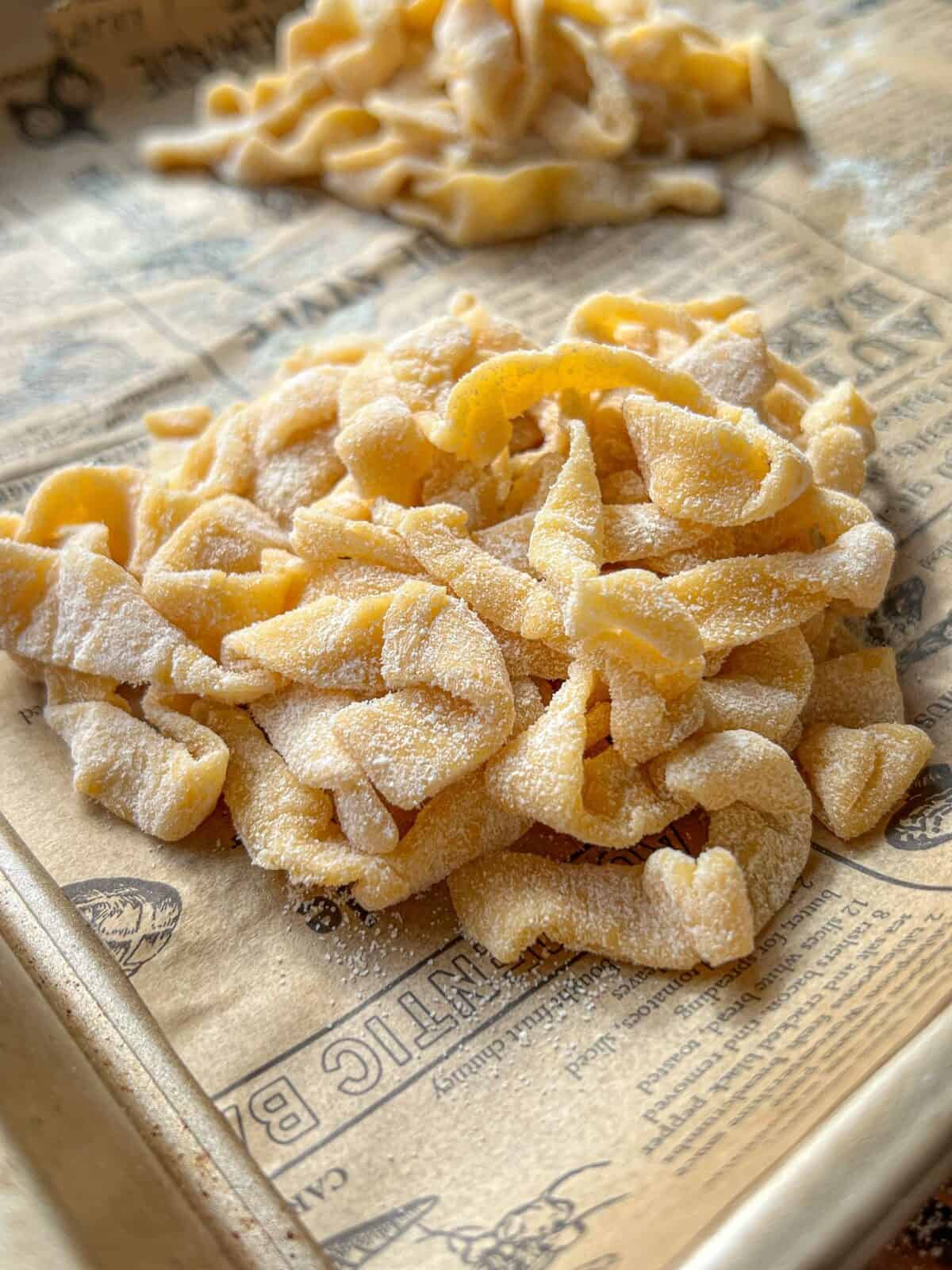
Why You’ll Love Easy Homemade Pasta
Silky, tender, and fresh, my Easy Homemade Pasta is love at first bite 🫶. In less than an hour, you can have beautiful, golden strands of pasta twirling around your fork like that ballerina in your 3rd grade jewelry box 🩰. Pair it with my homemade Italian Tomato Sauce or Vegan Alfredo Sauce for a match made in pasta heaven 😇. Or simply top it with fresh grated Parmigiano-Reggiano and a pad of salted butter for a simple-yet-elevated treat. Serve with your favorite proteins, like fresh seafood, homemade meatballs, or Chicken Parm for an epic Italian night 🇮🇹.
Ingredients
🌾 Flour: Both 00 flour and all-purpose flour will work. I like 00 flour because it has a fine, powdery texture that creates an elastic, easily stretched dough. And I always use a food scale to weigh my flour for the best results. For dusting, I like to use semolina. It doesn’t absorb as much liquid, and is your best line of defense to keep the cut pasta strands from sticking together.
🥚 Eggs: I like to mix in a whole egg plus one egg yolk for a tender, silky dough. The extra yolk adds rich flavor and a golden hue.
Nonna’s Tip 🥚
When mixing pasta dough, be sure to scoop flour from the bottom of the well. Adding it from the top can cause the eggs to run out.
Pro-Tips for the Perfect Pasta
I get it – making homemade pasta has a certain intimidation factor. Luckily, I’m two-steps ahead of you 😉. With these pro-tips, even the most novice cooks can make perfect homemade pasta.
- A good rule of thumb is 100 grams of flour per egg. For extra richness, add an extra yolk 🍳. Start with about 85 grams of flour and adjust as needed, since eggs vary in size. Remember: you can always add more flour as you go, but you can’t take it away 😉.
- Sprinkling semolina instead of flour when rolling out the dough is ideal to help prevent sticking. Semolina is more coarse, so it’s going to keep the dough more dry. If you use flour, it absorbs really easily into the dough making it more sticky.
- If you prefer, you can absolutely use a pasta machine or attachment to make thin, beautiful sheets. However, a rolling pin works fine and gives your Easy Homemade Pasta a rustic feel. Just make sure you roll it out very thin – almost see-through – as pasta swells slightly when cooked.
- To make farfalle, or bow-tie pasta 🎀, cut the dough into rectangles, press one finger in the center, then using your other hand, pinch the sides toward the middle.
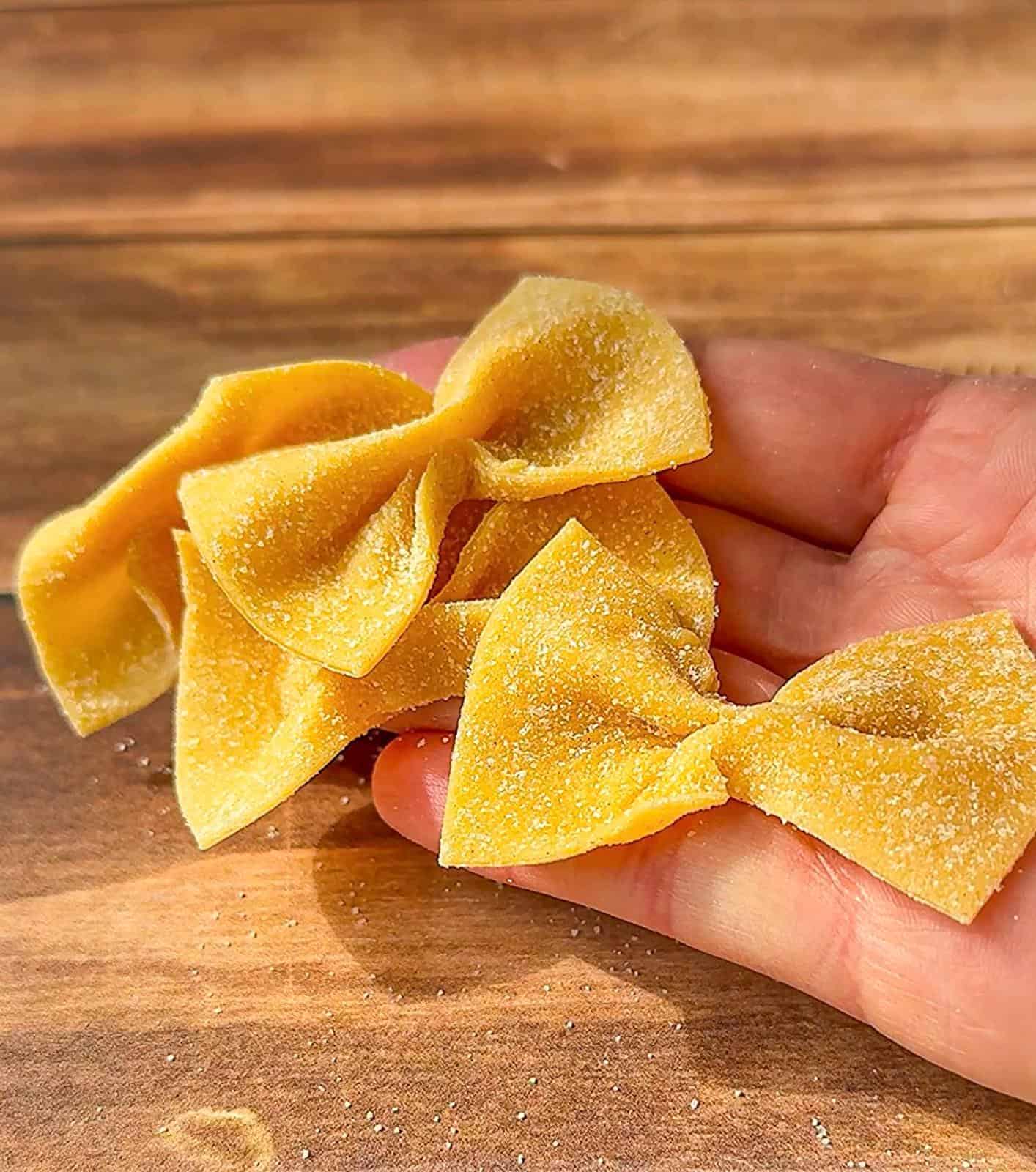
How to Cook Fresh-Cut Homemade Pasta
Homemade pasta lives by a different set of rules than dried, boxed pasta when it comes to achieving that perfect silky texture 🍝. Start by allowing your fresh-cut pasta to dry for 15–30 minutes on a semolina-dusted tray before cooking. This helps the strands firm up, so they’re less likely to stick together when you transfer them to the pot. However, you can also drop your fresh pasta into boiling salted water 🧂💦 immediately after cutting if you don’t have time to let it dry.
Be sure to watch it closely 👀. It will cook very fast — usually 2-3 minutes depending on thickness. So how will you know when your fresh pasta is done? Two words: taste test 😋! The texture will be soft and silky when done, as opposed to the slight bite you get from al dente boxed pasta.
Flour Variations and Substitutions for Easy Homemade Pasta
- All purpose flour: This is the Swiss Army Knife 🇨🇭🔪 of flours. Most people have it on hand, and it’s easily adaptable to just about any recipe.
- 00 flour: Fine milled 00 flour is powdery and light. It’s ideal for pasta and pizza 🍕 because the fine gluten strands are highly elastic, perfect for rolling into thin sheets without tearing.
- Whole wheat flour: High in fiber with a low glycemic index, whole wheat flour 🌾 is a great option if you’re on a restricted diet. Keep in mind that whole wheat absorbs more water, so be sure to let the dough rest to help it hydrate evenly.
- Gluten-free flour: If you’re gluten intolerant, look for a 1:1 gluten-free flour blend. Since gluten is what gives pasta its elasticity, you’ll want to ensure your dough has a binder like xanthan gum to keep it from breaking while rolling.
- Semolina: This classic is high in protein, which creates a sturdy dough It’s beautiful golden color and slightly rough texture are perfect for pairing with your favorite sauces 🍝.
Best Served With
- A pad of butter 🧈, a splash of pasta water, and fresh grated Parmigiano-Reggiano.
- My homemade Italian Tomato Sauce 🥫.
- With delicious proteins like Baked Chicken Parmigiana, Oven Baked Meatballs, or Creamy Tuscan Shrimp.
- A crisp, cool Italian Chopped Salad 🥗.
Similar Recipes
Cherry Tomato Pasta
15 mins
Lemon Shrimp Pasta
15 mins
Pasta Limone
15 mins
Meghan Markle Pasta Recipe
15 mins
Common Questions
Lightly flour your surface and rolling pin before working with your dough. However, be careful not to use too much, since we want the dough to hydrate properly.
Absolutely! Allowing your dough to rest for 25-30 minutes gives the flour time to hydrate properly and form strong gluten strands, making rolling out the dough much easier.
Roll your dough until it’s 1mm thick, about the thickness of a playing card. You should almost be able to see your hand through the sheet.
Fresh pasta cooks quickly – 2-4 minutes (depending on your desired level of doneness) in a pot of boiling salted water.
Of course you can! You can make your noodles ahead of time and store them in the fridge for up to 2 days before cooking.
Yes, you can! Opt for a 1:1 blend of gluten-free flour that contains a binder like xanthan gum. You may need to add extra to keep your dough from breaking.
Easy Homemade Pasta (No machine method)
Video
Ingredients
- 85 grams flour, 00 or all-purpose + more for dusting
- 1 whole egg
- 1 egg yolk
Instructions
- Weigh out the flour on a food scale and place it on the counter. With the bottom of a glass make a well in the centre making sure it’s wide enough so that the eggs don’t spill over the sides.
- Add in one whole egg + one egg yolk.
- With a fork, start whisking the eggs gently making sure to grab flour from the bottom as you combine.Note: Don’t add flour from the top as the egg can spill out of the well.
- Once the flour and eggs are combined, start kneading the dough with your hands. If the dough is sticky, add a light sprinkle of flour at a time as you knead until you have a smooth dough ball. I like to knead for about 5 minutes.
- Cover with plastic wrap and let it rest for 20-30 min. Once rested, lightly flour the counter and the top of the dough. Too much flour will toughen the pasta, but too little will cause sticking. Semolina is ideal for dusting.
- With a rolling pin, start from the center of your dough ball and roll outward, rotating the dough often.
- Aim for a thin, even sheet, about 1 mm (the thickness of a playing card). You should almost be able to see your hand through it.
- Lightly flour the sheet, then fold both sides toward the middle it into a loose flat roll. This will make cutting the pasta easier.
- With a sharp knife, slice across the fold into strips about 6–8 mm wide (the width of classic tagliatelle).
- Gently shake out the ribbons with your fingers and toss them in a little semolina so they don’t stick.
- Form into small nests or lay flat until ready to cook. Note: If you want to freeze the nests, place them in the freezer, once frozen you can transfer into a freezer bag and boil any time straight from frozen!
- To cook: Boil a pot of water and salt it generously. Once boiled, add in the pasta. Fresh pasta takes 2-3 minutes to cook so be sure to taste one of the noodles for doneness, if needed. My favourite way to enjoy is to toss the cooked pasta with cold butter, a tiny splash of pasta water, and fresh finely grated Parmigiano Reggiano. Enjoy!
Notes
- How to Mix: When mixing your flour and eggs, be sure to scoop from the bottom. Don’t add flour from the top as the egg can spill out of the well.
- Flour alternatives: You can make this pasta with any kind of flour you prefer: all purpose, whole wheat, 00 flour, semolina, or gluten-free.
- Semolina dusted strands: To keep your noodle strands from sticking together, dust them with semolina and toss to lightly coat.
- Cooking tips: Fresh pasta cooks fast! Let it dry 15–30 minutes on a semolina-dusted tray for easier handling, or boil right away in a pot of salted water. Watch closely and taste after 2–3 minutes for that soft, silky texture.
Nutrition
Nutrition information is automatically calculated, so should only be used as an approximation.




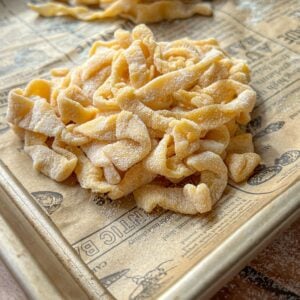
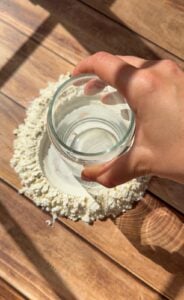
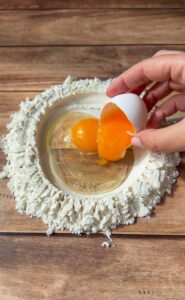
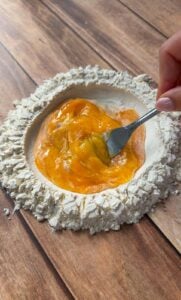
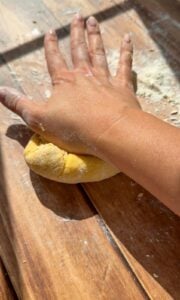
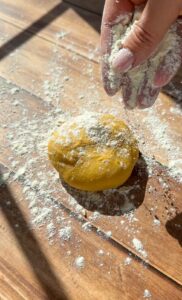
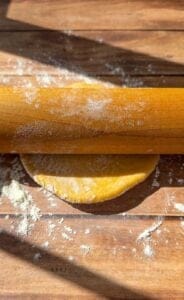
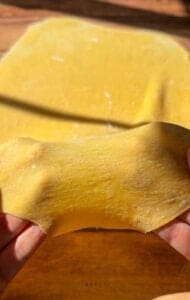
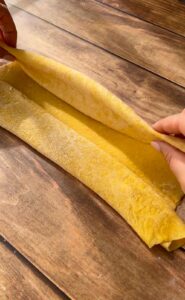
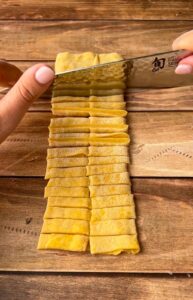
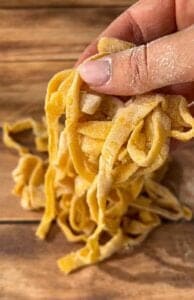
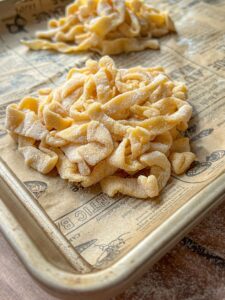
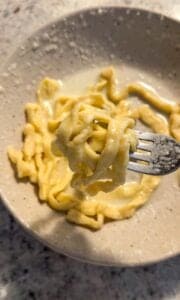

















This worked exactly as written, thanks! Super easy method that made me feel like a pro ☺️
This is brilliant! So helpful to see how you roll the dough without a machine.
I made this for dinner tonight and served it with your Maroulosalata recipe. My family absolutely loved it. The step-by-step instructions and tips were so easy to follow, even for this first timer. The meal was simple and comforting – one they’ve already asked me to make again!
Made this today and I can’t believe how easy it was!! Fresh pasta forever.
Didn’t think I could make pasta from scratch…but this was actually easy and turned out amazing. Definitely making it again!